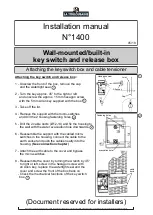
Operation diagnosis
13.1
Sending SNMP traps
188
UM Config GRS
Release
8.0
09/2019
13.1.2
SNMP traps for configuration activity
After you save a configuration in the memory, the device sends a
hm2ConfigurationSavedTrap
.
This SNMP trap contains both the Non-Volatile Memory (NVM) and External Non-Volatile Memory
(ENVM) state variables indicating whether the running configuration is in sync with the NVM, and
with the ENVM. You can also trigger this SNMP trap by copying a configuration file to the device,
replacing the active saved configuration.
Furthermore, the device sends a
hm2ConfigurationChangedTrap
, whenever you change the local
configuration, indicating a mismatch between the running and saved configuration.
13.1.3
SNMP trap setting
The device lets you send an SNMP trap as a reaction to specific events. Create at least 1 trap
destination that receives SNMP traps.
Perform the following steps:
For example, in the following dialogs you specify when the device triggers an SNMP trap:
Basic Settings > Port
dialog
Network Security > Port Security
dialog
Switching > L2-Redundancy > Link Aggregation
dialog
Diagnostics > Status Configuration > Device Status
dialog
Diagnostics > Status Configuration > Security Status
dialog
Diagnostics > Status Configuration > Signal Contact
dialog
Diagnostics > Status Configuration > MAC Notification
dialog
Diagnostics > System > IP Address Conflict Detection
dialog
Diagnostics > System > Selftest
dialog
Diagnostics > Ports > Port Monitor
dialog
13.1.4
ICMP messaging
The device lets you use the Internet Control Message Protocol (ICMP) for diagnostic applications,
for example ping and trace route. The device also uses ICMP for time-to-live and discarding
messages in which the device forwards an ICMP message back to the packet source device.
Use the ping network tool to test the path to a particular host across an IP network. The traceroute
diagnostic tool displays paths and transit delays of packets across a network.
Open the
Diagnostics > Status Configuration > Alarms (Traps)
dialog.
Click the button.
The dialog displays the
Create
window.
In the
Name
frame, specify the name that the device uses to identify itself as the source of
the SNMP trap.
In the
Address
frame, specify the IP address of the trap destination to which the device
sends the SNMP traps.
In the
Active
column you select the entries that the device should take into account when it
sends SNMP traps.
To save the changes temporarily, click the button.
Summary of Contents for GREYHOUND GRS1020
Page 8: ......
Page 16: ......
Page 146: ......
Page 232: ......
Page 310: ......
Page 330: ......
Page 338: ...Readers Comments 337 RM GUI GRS Release 8 0 09 2019 ...
Page 339: ......
Page 340: ......
Page 350: ......
Page 354: ......
Page 617: ...Readers Comments 277 UM Config GRS Release 8 0 09 2019 ...
Page 618: ......
Page 619: ......
















































